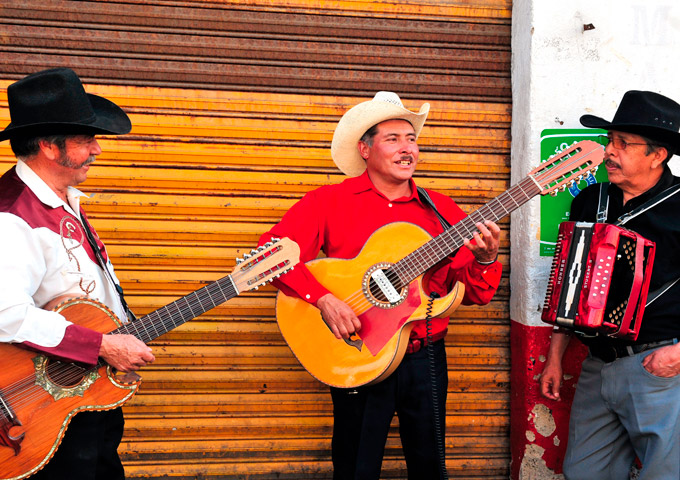The narrative of “corridos paracos,” the sung story of the conflict
By: Ximena Castro Gil
Photos:
Society and Culture

By: Ximena Castro Gil
Photos:
We tend to think about the armed conflict in terms of bullets and people in military uniforms, but its discourses are also evident in forms of popular culture, as in the case of music, which has considerable influence in transmitting ideologies”, explained Eduar Barbosa Caro, a professor in the Journalism and Public Opinion Program of the School of Human Sciences at Universidad del Rosario, who, together with Johanna Ramírez Suavita, who has a Master’s in Communication, Development, and Social Change from Universidad de Santo Tomás, analyzed ‘corridos paracos’ as a tool for the construction of ideologies.
When discussing corridos, the first referent is the narcocorrido in which the band refers to characters and deeds of drug dealers; however, there are also"corridos paracos", which are quite similar but refer to people and facts outside the law that have historically represented a problem for the country, have a considerably strong far-right slant, and swear by an extremely violent political ideology.
These musical productions make a subgenre of popular music known as prohibited corridos wherein there are also guerilla corridos.
The three have similarities in their interpretation, such as the instruments they use as well as the rhythms and the way of singing; further, for the most part, they encourage crime, violence, and terrorism as almost all their lyrics enhance the protagonists and their actions outside the law.
However, “By analyzing the lyrics, the content of the ‘paracos’ is different because it specifically refers to certain people and is aimed at a specific audience”, explained Barbosa, deputy editor, Disertaciones Journal.
Stories that are told only in songs
According to the study, the ideals of one of the bloodiest groups to have affected the country are still seen as valid by a significant portion of the population, regardless of their socioeconomic position, religion, or geographic location. Therefore, as long as there are people who believe that the ideologies and procedures of paramilitary forces are an alternative of the social order, there will be representations of this underworld and followers of these corridos who will see such representations as a way of understanding conflicts and as a resource to consolidate and validate activities that occur at the margins of the law.
ne of the peculiarities that caught the attention of the researchers was the exposure of these musical formats (songs and videos) on digital platforms such as YouTube. Although these works are prohibited in official entertainment media, merely typing‘corridos paracos’ on the web displays a page with a large number of productions that contain, in their characteristics, a certain narrative freedom.

“In a polarized nation that needs reconciliation, these musical productions do nothing to help these goals”, explained Eduar Barbosa Caro, professor in the Journalism and Public Opinion Program of the School of Human Sciences at Universidad del Rosario.
The harshness with which the stories are told makes this musical trend be seen in two extremes: One, the great popularity it has in certain audiences; two, the rejection and repudiation it faces from another large social sector as these stories are reiterative in their categorization within the ‘advocacy of crime’. Through their lyrics, which speak of what few dare to tell, these kinds of songs become an alternative narrative resource to official speech.
Professor Barbosa explained that as part of the cultural collection, this has permeated our culture considerably as it is assumed that those who listen to them do so because they like it. These songs drive an agenda, a political and armed ideology that is not only for those who do not know them and have their attention attracted by listening to them but also for those who have a well-defined structure of thinking. Other links are generated or reinforced by them; in the end, they become an echo chamber, wherein those who think and feel alike converge. The songs are not only an instrument for the promotion of ideology but also a method of reinforcement for those who already hold this ideology.
From the discursive analysis of the ´corridos paracos´ made by Barbosa and Ramírez, a paramilitary member introduces himself as a person who is willing to go to war to save the country. “Very probably, that idea is the one that underlies the niche where these musical productions are directed to”, the authors indicate.
For their part, according to this research study, women appear in speech only as an object or a reward for the individual who is strong and brave enough to build a name among these groups. The proposed lifestyle, including cars, alcohol, weapons, and activities that are conducted with impunity, reflects a paramilitary aesthetic in the face of weakness, passivity, and lack of courage from those who face them.
In terms of discourse, a possible difference between the message of the paramilitary corridos and the music produced by the guerrillas is that the latter could show certain different affinities toward farmers, and the guerrilla woman, who is given a leading role and is recognized as playing a relevant role in the organization, although the guerrilla corridos also exalt the same guerrilla fighter and violence.
The paramilitary forces describe themselves as believers, arguing that a supreme being protects them(“In the most difficult combats/ always my God is protecting me/ here in the jungle, / in Punta Hermosa and El Trincho”). They are subjects that accept that they flee from the law and that they walk with impunity (“I am aware that the law goes after me/ and because I am paraco I have to be running away”); however, at the same time, they trust the Military Forces to fight against the guerrillas and call the armed forces that oppose them traitors.
In Colombia, there are geographic regions that have certain affinities with the paramilitary forces, particularly where they have been present.
It is easy to identify the areas of the national territory that are dominated by each of the illegal groups.
The songs mark territoriality, and the forces do not allow guerrillas to enter that territory. They restrict the population to those that identify with them; hence, music becomes an instrument of resistance against other ideologies, that is, depending on the music that is heard in the region, an affinity of the population toward one or another group is shown.
As in the guerrilla productions, performers are musicians who take part in the organization, but there are also bands of corridos that simply tell these stories as they happen with the narcocorridos.
These musical pieces comprise an x-ray of a cultural ideology, and although the policy structures of the paramilitary forces have changed, the messages and the roots remain. In this regard, the researchers argued that their speeches may not have varied substantially: “One may have heard them 15 years ago or today, and it is practically the same. A whole aesthetic of the paramilitary is formed, their lifestyle, what they have done, all the women they have, and that they are the fiercest”, the researchers affirm.
The final message of the song is not ‘become a paramilitary member, come and join us,’ but rather, it tells you the story of a brave man who moved ‘forward,’ who defended his land, and who did not want to see guerrillas in his town,” the researcher of the Identity Studies Research Group from the School of Human Sciences pointed out.
The study model analyzed variables such as actors, actions, types of weapons, and the most common words and their frequency, which allowed them to discover that more than 90% of the actions mentioned related to war, while 1.2% comprised actions of peace. The aforementioned contains a contradictory message because in the words of the researcher, they are presented as saviors but perform actions that are warlike, bloody, and violent. “The message is: ‘‘I’m going to end the war but because I am going to kill everyone’; hence the importance of context. That allowed us to conclude that according to the discourse, we can see how they illuminate the life of a group while vilifying that of their opponents”.
Barbosa emphasizes that “in a polarized nation that needs reconciliation, these musical productions do nothing to help these goals”, as the messianic and violent discourses have not disappeared, musical productions merely follow the order of the day.